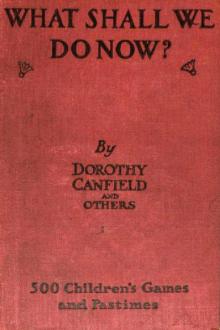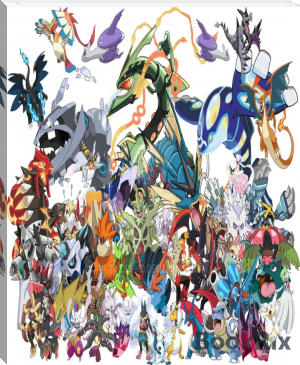What Shall We Do Now? by Dorothy Canfield Fisher (books on motivation .TXT) 📖

- Author: Dorothy Canfield Fisher
- Performer: -
Book online «What Shall We Do Now? by Dorothy Canfield Fisher (books on motivation .TXT) 📖». Author Dorothy Canfield Fisher
Puppies at first need feeding five times a day. At four months old four meals will do. At twelve months they settle down into grown-up dogs, and the two meals are sufficient. Do not feed them later than six o'clock, and always give them a walk after their last meal. A few dry dog-biscuits when they go to bed will do no harm, and a large mutton or beef bone now and then will do them good, but small bones are very dangerous, as they splinter and may kill or seriously injure the dog.
DistemperYoung dogs are almost sure to have distemper, and if a puppy about six or eight months old is depressed and quiet, and his eyes look inflamed, you should put him away by himself at once, sew him up in thick warm flannel, bathe his eyes with cold tea, and attend very carefully to his diet. It will be difficult to make him eat, but you must coax him and even pour strong beef-tea or milk down his throat, for if he does not eat he will have no strength to fight the disease. Tripe is the best food for him if he will take it, but try everything to tempt him, and give him as much as he will take. When you take your patient for a walk (and he will need exercise) do not take him where he may meet other dogs, for distemper is very infectious. Put an extra coat over him, wrapping it well round his throat and chest. Distemper is a fever, and the risk of chill is very great; it means inflammation of some sort from which the dog being weak is not likely to recover. It is always best to call in a veterinary surgeon when a dog shows symptoms of distemper.
Tricks for DogsIf your dog is a terrier there is no end to the tricks you can teach him. Always begin by teaching him to "trust," for it is the foundation of his training, and he will learn it before he is two months old. Do not keep him "on trust" for more than a second or two at first, but gradually make the time longer, until he will let you leave the room and not touch the biscuit until you return. Then you can teach him to die, and waltz, sing, ask, box, and beg. Treat him always with patience and firmness; be quick to reward but never give in to him. You will, of course, bear in mind the character of the dog in teaching him tricks. Dogs of dignified nature, such as St. Bernards, mastiffs, Great Danes, and deer-hounds, for example, you would not labor to transform into performers. The best dogs of all for teaching elaborately are poodles.
What is Due to DogsDo not overdo your mastership. Remember that a dog needs much liberty and independence to develop his individuality, and an enterprising puppy learns more by observation and experience in a week than a pampered lap-dog does in his whole life; he learns self-reliance, but he will always run to his master or mistress in any real difficulty, and you who are his master or mistress must be wary not to misunderstand or disregard him, for he needs sympathy and love, and if he does not get them he either becomes cowed and stupid or a ne'er-do-weel.
Buying DogsIf you wish to buy a dog, the best way is to get the catalogue of some big dog show, and find the address of a well-known breeder of the kind of dog you wish to have. If you write to him and tell him exactly what you want he will probably send you a suitable puppy at a fair price. If you think of buying through an advertisement, have the dog on approval first. Another objection to buying a dog at all casually is that you will not know either his temper, which is generally inherited, or his age. In all cases it is best to buy puppies and train them yourself. This means a good deal of trouble at first, and takes time and patience, but the younger the puppy the easier he is to train. The best age is about five weeks old. With constant attention day and night for a few weeks you will have a perfectly trained dog who will be a perfect companion to you for years.
Brief descriptions of some of the best known dogs are here given, beginning with terriers:—
The Bull-TerrierThe bull-terrier is very discriminating in his attachments and does not easily lose his temper, or, as a rule, fight, unless he is unduly excited. He is such a nervous dog that if he is roughly treated he is apt to become a coward, but there is no truer, more faithful friend than a properly trained terrier of this breed.
The Fox-TerrierThe fox-terrier is often a restless fidgety dog in a house; indeed, to keep him much in the house seems to affect his intelligence. He fights readily, but a strong master can alter that. In sharpness and brightness and hardiness he is not to be beaten, and no dog is more inquisitive and full of spirits. Perhaps of little dogs he is the best.
The Irish TerrierThe greatest fault of the Irish terrier is his fondness for barking unnecessarily; but he is particularly intelligent, active, and vigorous, and will learn any trick your ingenuity can devise for him.
Other TerriersThere are many other terriers—the Skye, with coat nearly sweeping the ground; the black and tan, the Welsh terrier, and others less well known; but for pluck, brains, and fidelity, it is impossible to beat bull-terriers.
SpanielsOf all spaniels the Clumber is the most intelligent and beautiful; he is also, although not a very demonstrative dog, very sincere in his devotion to his master.
The Cocker is a small spaniel: an active, merry little fellow who can be taught to retrieve. The black spaniel and the liver-colored Sussex are, like the Clumber, of the oldest and best breeds, and the Sussex variety makes an excellent house dog. He is quiet and dignified and has very good manners. The common Norfolk spaniel is intelligent, a good water dog, and a faithful companion. A satisfactory puppy should not cost more than five dollars. He and the Cocker are the best of the spaniels as pets, although these two breeds are also capable of good work in the field if carefully trained.
The RetrieverRetrievers occasionally make good companions, but for the most part they are dogs of one idea—retrieving—and have little interest in using their intelligence in any other direction.
SettersThe setter is a wise and affectionate animal. He is full of spirit and needs careful training, but train him well as a puppy and you will be able to take him everywhere with you, for he is a very gallant and courteous gentleman. In color the English setter varies with the different breeds. The Gordon setter is black and tan, and the Irish is red.
The CollieThe reputation for uncertain temper which collies have is not well grounded. They are excitable, it is true, and apt to snap if you romp too long and wildly with them, and they do not take correction kindly; but people who have owned many specimens of this beautiful breed testify to having found them always loving and sagacious. A collie should always belong to one person; many masters make him too universal in his affections, and under these circumstances he does not develop intelligently. The collie at work is the wisest of dogs, he knows each individual sheep in his care, and in snow or mist will bring every one to the fold before he rests.
Collies may be taught to play hide-and-seek—a game they are very fond of. First hide a ball in the room and help the dog to find it, and by degrees he will find anything by himself and will seek all over the house and garden. Among bad habits many collies have the serious one of running round and barking at horses. This should be checked by keeping the dog strictly to heel where he is likely to meet any traffic.
The Sheep DogThe old English bob-tailed sheep dog is a bouncing, rough-and-ready fellow. He is not suitable for a house dog, but he is honest and true and a good worker, and one can get extremely fond of him.
The NewfoundlandThe Newfoundland is one of the grandest of beasts. The true Newfoundland is black all over, except for a white star on the chest, and he stands at least twenty-seven inches at the shoulder. The black-and-white specimens are called Landseer Newfoundlands, on account of the famous painter's fondness for them. In character these dogs are dignified and magnanimous, and they are particularly good with children. Many stories are told of their gallant efforts in saving life from drowning. The Newfoundland is used for draught in the island from which he takes his name.
The MastiffThe mastiff is the best of all guards; it is more pure instinct with him to guard his master's property than it is with any other breed. He is honest through and through, and as a rule he is gentle and a good companion.
The Bull-DogThe bull-dog is stupid and not particularly affectionate. Although excitable he is not quarrelsome or savage, and if reasonably treated no doubt would make a quiet, faithful pet. A not too highly bred bull-dog is likely to be more intelligent than his very blue-blooded relations.
The St. BernardThe most majestic of dogs is the St. Bernard. He is high-couraged and sagacious and very discriminating in his devotion. Once your friend, he is always your friend. Although with you he never makes a mistake, he is apt to growl at strangers, and is not to be relied on to be polite to visitors. If you have one of the rough-coated variety you must groom him regularly and take great care of him, as he is a delicate dog and subject to weakness in the back and hind legs if he is allowed to get wet or lie on damp ground.
The Great DaneThe Great Dane, or boarhound, is a powerful and active dog. His appearance is suggestive almost of a wild beast, and he is particularly well fitted to act as guard. He is gentle and manageable with those he knows, and his great courage, intelligence, and strength make him a most desirable companion.
HoundsOf hounds that hunt by sight we have the English Greyhound, swiftest of dogs, but neither very intelligent nor affectionate; the Scotch Deerhound, dignified and very devoted to his master, and a wonderful jumper over gates and walking-sticks; and the Irish Wolf-hound, bigger and less graceful than either of the others, but with a great big heart and noble courage. Gelert was of this breed. There is also the Borzoi, whose appearance is a combination of greyhound and setter, a very beautiful but rather stupid animal.





Comments (0)